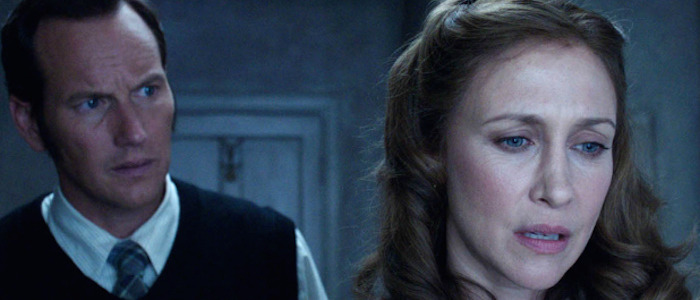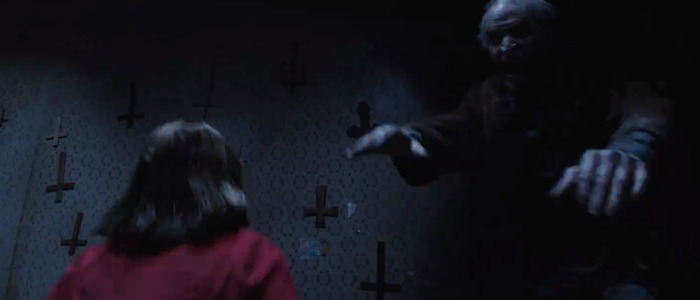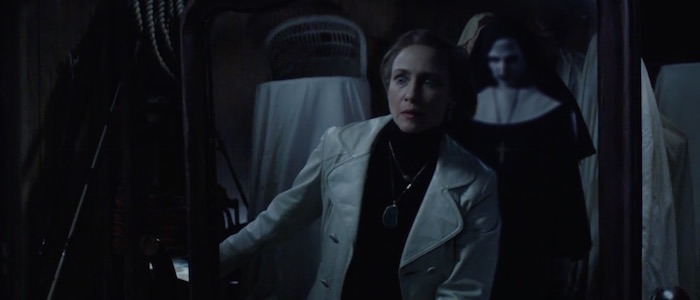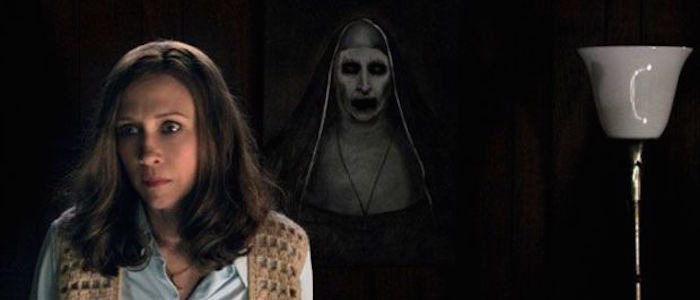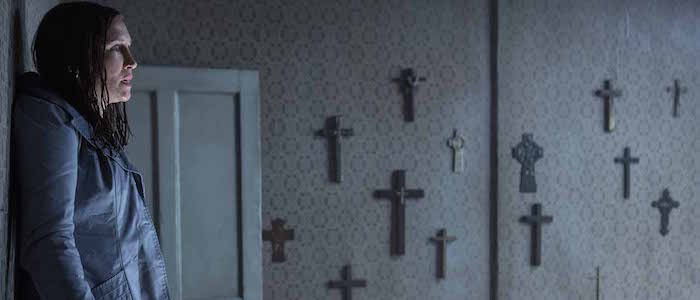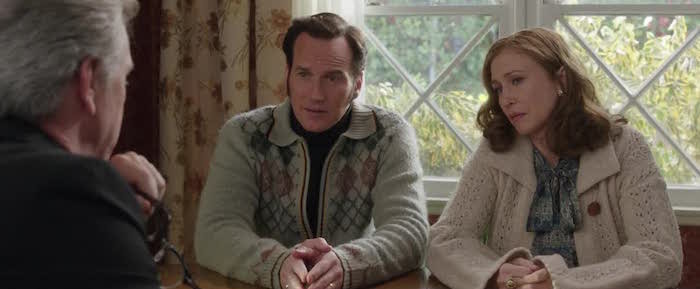'The Conjuring 2' Spoiler Review: James Wan Gets Scary And Sentimental With One Of The Best Horror Sequels Ever Made
The Conjuring was one of my favorite films of 2013 and remains a genuine contender for one of the best horror movies of the past decade. At the time, it felt like a summation of everything director James Wan had accomplished until that point: it was a clever crowdpleaser filled with scares, but it was also character-driven and classy, recalling an age where horror movies didn't have to appeal to the lowest common denominator.The Conjuring 2 ranked high on my most anticipated films of 2016 list and my faith was not displaced. Although not quite as good as the first film, this is one of the best horror sequels ever made, capturing what made the first movie so special and sprinting with it. With Wan taking another break from horror to make Aquaman, this is a perfect and fitting a tribute to the genre that made his career, a gift to people who like horror movies with a little bit of ambition. Let's take a closer look at what makes The Conjuring 2 work so well...and what holds it back from being as good as the first one. SPOILERS ahead.
Two New Horror Icons
The basic nature of the horror genre leads to the canonization of its villains. Nobody remembers the name of Jason Voorhees' victims – they remember the hockey masked killer who transforms them into mincemeat. Nobody quotes the poor schmucks getting torn asunder in A Nightmare on Elm Street – they're quoting Freddy Krueger's grotesque wisecracks. Characters like Michael Myers and Leatherface are joined by the likes of Frankenstein's monster, Count Dracula and the Phantom of the Opera in this particular club. Even when the bad guys are defeated, they always return for the sequel. The bad guys are the draw. With the notable exception of Ash from the Evil Dead series, the villains, the monsters, are the main draw for just about every horror series.
And that's what makes The Conjuring and its sequel so damn refreshing. While the demonic forces paranormal investigators Ed and Lorraine Warren face off against in these films are intimidating and scary, they are also mysterious and vague, forces that cannot be be understood because they do not want to be understood. That means that the stars of these movies are the Warrens. This is the rare horror story whose central heroes are the main draw. The chief appeal of The Conjuring isn't that it'll scare you silly (and it is a nerve-wracking movie), it's that we get to watch the Warrens tackle another case together.
Ed and Lorraine are everything that most horror protagonists are not. They are smart. They're on the same page. They do not underestimate the threat at hand. It's telling that both of these movies spend a long time establishing a family being haunted and terrorized by supernatural forces before bringing these two directly into the main plot. Once they arrive, stuff starts to get done. For a genre that so often relies on everyone on screen being a total idiot, the competence of the Warrens is refreshing. Neither of their films have treated them as superhuman and they are not immune to fear, but they have the steady calm and professionalism of people who have been doing this for years. They're fun to watch because they are recognizably human and because they are fairly normal people who just so happen t0 be extraordinarily good at their very unusual job. It helps that each one is an expert in different corners of paranormal research. They function as a team because their work constantly highlights how their different areas of expertise complement one another.
It's not clear how or if this series will continue (the weekend box office suggests that a Conjuring 3 will probably happen), but it's safe to say that Ed and Lorraine Warren genuinely feel like modern horror icons, characters who have secured their place in the larger horror canon. It's rare enough for horror heroes to outshine their monsters and it's even rarer for two horror leads to showcase such incredible chemistry, to sell us a relationship that feels so lived-in. The casting of actors as fine as Patrick Wilson and Vera Farmiga is key here – they form the rock-solid core around which an entire movie can be built. They believe what they're seeing, so we believe it. They're unlikely performers to emerge as two of horror's finest recent creations and that's exactly why they work.
A Pattern Emerges
Whether by accident or design, The Conjuring 2 echoes the basic shape of the first film. Like its predecessor, the sequel opens with the Warrens investigating a case that is seemingly unrelated to the main plot, an opening scene that serves to rattle the audience and establish a mood. Like James Bond, Ed and Lorraine get a quick pre-credits adventure to establish their bonafides right off the bat. In the sequel, it's the haunting at Amityville (revealed through a brilliantly self-aware opening shot from behind those infamous windows) and you have to admire the nerve of Wan and screenwriters Carey Hayes, Chad Hayes, and David Johnson. They take one of the most famous haunted houses of all time, the most famous case of the Warrens' career, and they relegate it to the opening moments. It take a lot of nerve to say "Amityville? Yeah, sure. But just wait until we get to the really scary stuff."
Also like its predecessor, the film then proceeds to put Ed and Lorraine on the back burner for long time as we are slowly introduced to another family who are being menaced by a haunting. In this case, it's the Hodgsons, a London family consisting of a single mother and four children who find themselves under assault by a violent ghost with mysterious motivations. While the film wisely cuts back to the Warrens just often enough to keep them in our minds, it's impressive just how much screen time is granted to the Hodgsons. Like with the first Conjuring, we are allowed to understand the dynamic of the victim family and understand their predicament from their point of view. By immersing ourselves in their nightmare, the arrival of the Warrens deep into the film feels like the calvary riding to the rescue. Someone is here and they've brought answers. The presence of the Warrens is impactful because we've spent a good 45 minutes being immersed in a very-well made, albeit straightforward haunted house story.
The echoes continue. Ed and Lorraine investigate. They get to know the family. They help out around the house and attempt to restore normalcy. Other investigators, consisting of both believers and skeptics, join the fray. And then things get really bad and the identity of the threat is revealed and that seemingly unrelated case from the start of the film comes back in a big way to ensure that this isn't just another case for the Warrens – it gets personal. They have to solve it for the family and for themselves.
Horror sequels following the same beats as their predecessors is nothing new. Normally this is a sign of laziness, evidence that the shepherds of the series want to replicate what works instead of breaking new ground or being adventurous in any way. However, the familiar structure of The Conjuring 2 feels less like cheap copy or more like a fresh coat of paint on a template that worked. The similarities feels not only intentional, but slightly cheeky. Wan has built a structure that can be endlessly riffed on without feeling tired. As long as the individual components function well, this particular piece of cinematic housing could host an ongoing series. And right now, I feel like I would gladly watch a new case from the Warren files every three years or so until everyone involved simply decided to give it all up
Bigger, Louder, Longer
The Conjuring 2 is 134 minutes long, a good 45 minutes or so longer than your average horror movie. The first Conjuring was already long for this kind of movie at 112 minutes and the sequel doubles down its length. For better and worse, The Conjuring 2 doesn't feel the need to fit in that lean 90-minute box that is so common for scary movies. It's one of the more indulgent horror movies in recent memory.
On the negative side, you can feel those extra minutes hanging off the film, slowing the pace and causing the film to enter a few lulls that simply aren't present in brisker horror movies (where there is literally no time for things to slow down too much). The Conjuring 2 feels as long as it is and it's a bit of a butt-numbing experience. This would probably be a better film if it was twenty minutes shorter and this sense of bloat is what keeps it from being quite as good as part one, which barrels forward with abandon at every possible moment.
In fact, every element of The Conjuring 2 is simply bigger than the first film. It's not just longer: the scares are grander, the threats more significant, the ghosts more extravagant, and the set pieces more reliant on visual effects. You can tell that this is a haunted house movie made by the same man who just made Furious 7 – Wan added a number of new tricks and tools to his arsenal and he's more than happy to utilize them here. This may be the loudest horror movie to come along in quite some time.
And yet, this plus-sized and bombastic take on familiar territory is also weirdly refreshing. This kind of movie is generally made on a budget, produced for pennies by filmmakers who have to think up clever solutions to their storytelling problems because they often don't have the cash to fully realize a concept. Wan himself is no stranger to this. Just look to Saw and Insidious to see him battling his budget to create something effective. The Conjuring 2, which arrives after his previous film made over a billion dollars at the international box office, finds him working with a budget that is twice the size of the original Conjuring. Wan has the clout to command larger budgets, which means he can create horror movies that don't need to look or feel cheap. Even when this film feels a little bloated and a little sluggish, it's undeniably polished and slickly made by a filmmaker who has finally been given the money to go all-in on his grandest ideas.
The climax of The Conjuring 2 finds Wan's old and new sensibilities colliding in unexpected ways. It's still very much a horror sequence, as Patrick Wilson's Ed navigates a hostile and haunted home after being partially blinded by steam, but it operates on the level of a major summer release. The house crumbles as each jump scare tears walls apart. The arrival of demonic forces cause theater seats to shake as the speakers are tested within an inch of their lives. There's action movie language at work here, especially as Ed and a young victim dangle from a window and Lorraine rushes to the rescue. Horror movies are usually content to be small, to deliver simple thrills and call it a day. Horror movies rarely feel like this. The length and scope of The Conjuring 2 is a blessing and curse – James Wan believes that horror can be big, that it can be grand, and that it can operate on a wilder and more ambitious plane. The film bites off more than it can chew, but there's something admirable about that.
The Art of the Jump Scare
The most important thing about The Conjuring 2 is that it's frightening. A few good scares can go a long way toward forgiving a movie's other sins and if there is one thing James Wan is good at, it's delivering a few good scares. In fact, the sheer length of this film means that it includes more terrifying moments than most other horror movies by default – there is simply more time to deliver more set pieces built around scaring the crap out of you.
Anyone can create a jump scare. You have something suddenly enter the frame and you include a sting on the soundtrack and an audience will jolt in their seats though sheer surprise. Something unexpected happens and the body reacts. But James Wan knows that the best jump scares aren't about that final physical jolt. That's the pay-off, the release of tension. Once it happens, the scare is over and the audience resets as they momentarily relax. So Wan builds to that jolt, taking great pleasure in pushing sequences to their breaking points and pushing our personal buttons. He knows that we know something is coming. He fills his frame with distractions and dead spaces, forcing us to search every frame for the threat that we know is coming. His camera treats us like prey. We know we're being hunted and he allows us to see as much as possible, panning across rooms and cutting back and forth from various angles, setting us up with a false sense of security because that hallway or that closet is clearly empty.
But that's the greatest trick in Wan's toolbox. His monsters don't exist in the spaces we can see – they exist in the empty space between cuts. His ghosts and his demons do not follow the rules of the physical world. If anything, they are aware of the fact that they're in a movie. They enter the frame at the most unnatural moments because they can, because Wan gives them the freedom to manipulate our perception. There isn't a single shot in The Conjuring 2 that feels like an accident. Wan knows where to place his camera to keep to keep us off-guard and, more importantly, he knows where to place his camera when he wants to put us on-guard. He knows how we watch movies and he uses that to his advantage. The tension is so unbearable that we beg for something to happen, for the release that comes with the scare that we all know is coming. That's the real magic trick.
The Conjuring 2 is frequently frightening, but two scenes stands out in particular several days after having seen the movie. In one, Lorraine Warren, having seen a blasphemous demon in her own home, follows it to her husband's office and finds herself stalked in the shadows as the creature takes advantage of a painting on the wall to hide in plain sight. The scene is unbearably long, with Wan inviting us to look into every corner of the room even though that painting, hovering over Lorraine's shoulder, serves as a constant reminder that something is right behind her in every single reaction shot.
In the other, Ed Warren interrogates a presence that has inhabited a young girl with his back to his subject. Wan films this interview in one long take, keeping the camera in close-up on Patrick Wilson's face while his subject sits in the background, out-of-focus. We don't even notice when the blurry shape of the young girl transforms into a blurry shape of a decrepit old man. Unlike the sequence with the painting, there is no big sting here, no final burst of terror. There is only the lingering sense of wrongness...and we're forced to carry that unease into other scenes without release.
The Lulls Between Scares
It's the moments between scares that separate a good horror movie from a great horror movie. How a movie like this chooses to bide its time when it's not working to terrify you is vital. In so many cases, too many cases, it feels like your time is being wasted, like the movie is simply killing minutes until it can get back to the "good stuff." The miracle of both The Conjuring and The Conjuring 2 is that James Wan and his collaborators actually take this time to ask you to care about everyone on screen.
In both films, the arrival of Ed and Lorraine at the haunting is quickly followed by them attempting to restore the victims' daily routines. The best way to battle an otherworldly threat is to retain as much of yourself as possible, they say. This means sequences set around the breakfast table, scenes where Ed assists with odd jobs around the house, and Lorraine getting to know the kids and helping act as the calm centering presence they so desperately need. These scenes not only endear us to the Warrens, who are presented on screen as genuine and sympathetic people, but they give us the enough time to meet and understand the people they are trying to help. The Conjuring and its sequel do something that precious few horror movies attempt: they ask us to give a shit about everyone on screen.
When the third act rolls around and things really go to hell for the Hodgson family, we have been given reason to care about every member of the family. Because we have spent so much time with their friendly neighbors across the street, their presence as allies feels like it matters. Simon McBurney's Maurice Grosse isn't just another warm body present to help dump exposition, but a full-fledged character whose motivation has been explored and who has a reason to be there. In a film where the threat is often more spiritual than physical, this is vital – we can only care about the souls of these characters if we care about them.
The Conjuring 2 is scary and it delivers the roller coaster thrills and chills you'd want from it, but it's also sweet and sincere and even a little goofy. Its characters are endearing and their conversations more than placeholder text on the way to the next jump scare. The amount of time spent getting to know everyone contributes to the film's length and to that above-mentioned sense of bloat, but it ultimately feels like a fair trade-off. It's better to care too much about the people in a movie that's a little too long in the tooth, than to simply watch people you barely know survive a series of scares for 90 minutes.
Ed and Lorraine: A Love Story
It turns out that James Wan has a bit of a sentimental side and it's on full display in The Conjuring 2. Does a haunted house movie need a scene where one of the paranormal investigators breaks out a guitar and serenades everyone with some Elvis to help alleviate familial tension? No, it doesn't. but I can also say that I don't think I've ever seen a moment quite like that one in a horror movie. Watching Patrick Wilson croon "Fools Rush In" is what separates this movie from the rest of the pack. It's sweet and a little silly and blissfully humane. Most importantly, it informs the most important aspect of both Conjuring films – the relationship between Ed and Lorraine and just how much these two love another.
I've already touched on why these two are so appealing. Their competence in the face of danger and the professionalism they bring to situations where everyone around them has been frayed down to the bone is exquisitely entertaining. However, they are truly endearing characters because their partnership feels deeper than a working relationship. The Conjuring 2 isn't content to just say these two are married and then treat them like co-workers. They are clearly, deeply in love with one another, so comfortable in one another's presence that the film doesn't even try to generate false conflict between the two of them in the name of drama. They are comfortable with one another. They talk through their issues. They're honest and reasonable. Wilson and Farmiga make standard domesticity compelling, because a depiction of a genuinely happy marriage between two people who operate on the same wavelength is rare in any movie. That this standard domesticity exists within a movie that is wall-to-wall with ghosts and demons makes the fact that they're a fairly "boring" couple inherently interesting.
It's telling that The Conjuring 2 doesn't end with one final jump scare to send the audience out screaming. It ends with Ed and Lorraine dancing in each other's arms, home and safe. The victory isn't that they have saved another family from a demonic presence – the victory is that their relationship remains as intact and as solid as ever. It's hard to recall any mainstream horror movie caring so deeply about its characters. It's hard to recall many horror movies in general that are ultimately about the power of family and the strength of love. Hokey? Sure, maybe a little. A welcome change of pace from a genre that tends toward the nihilistic? You betcha.

